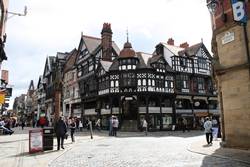 |
RS Home |
Chester |
|
|
The City is a popular tourist destination for its Roman connections, city walls, timber framed buildings, boat trips, kyaking, and shopping. Over 50 Attractions in and around Chester. 24 Large Images with History |
| Hotels | What's On | Self Catering |
| B&Bs | Casinos | Restaurants |
| Hostels | Cinemas | Night Clubs |
| Golf | Theatres | Websites |
|
Chester began as a Roman fort named Deva Victrix, in AD79. The Romans left the area around 410. The area continued to prosper after the Romans left, then expanded more during Saxon rule from the 600s. William the Conqueror, from Normandy in France, took control of England and Chester from 1066, leading to modern Britain. William the Conqueror had a Castle built at Chester to protect the area and secure the Welsh border. The old Roman walls were rebuilt and extended from this time, being completed in the 1100s. These walls run round the oldest part of Chester, at about 2 miles around, now a top visitor attraction. The earlist parts of Chester Cathedral are from 1093, with much of what can be seen today from the 1200s and 1300s. Many of the Timber Framed buildings around Chester centre, such as in the image top, were built from the 1400s to 1800s. View a list of old buildings to view. The Eastgate Clock is on the East Gate in Chester centre, where the entrance to the Roman Fort was situated. This is claimed to be the second most photoghraphed clock in England, after Big Ben in London. The present Eastgate was built in 1768, with the clock being added in 1899 to celebrate the diamond jubilee of Queen Victoria. Chester Town Hall was completed in 1869 in gothic revival style. The Town Hall is now mainly used for functions and weddings. The Roman Amphitheatre in Chester centre was discovered in 1929 during gardening work at Dee House. This Amphitheatre is the largest found in Britain so far, dated to around 1AD. The Newgate Arch Bridge on Pepper Street was built in 1938 to allow more traffic in and out of Chester. The old City wall path runs over the arch. The River Dee runs through the centre of Chester, popular for scenic walks, boat tours, kyaking hire, and kyaking lessons.
|
